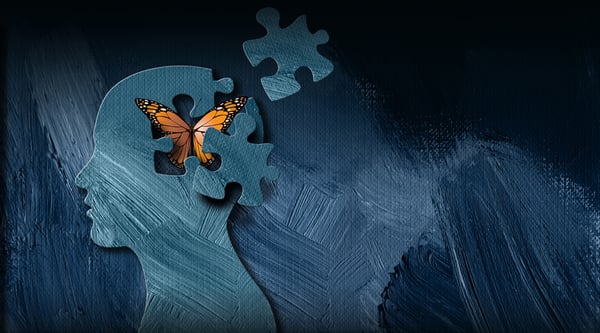Devil or Angel? The Process of Diagnosis for Autistic Children
What is ‘diagnosis’ anyway? Why have a diagnosis? How do I know if my child’s autism diagnosis is accurate? Could it be something else? Where do I go for answers? These are some of the questions that parents, therapists, and teachers ask about an Autism Spectrum Disorder (ASD) diagnosis.
Some years ago, I gave a talk to teachers and parents called “Devil or Angel: The New DSM” because the DSM (Diagnostic and Statistical Manual of Mental Disorders) had just come out in a new edition (the 5th) and, among other changes, eliminated the diagnosis of Asperger’s Syndrome. The DSM is used by providers in the process of diagnosing all mental disorders. Parents and providers were confused by the changes, and many adults with that diagnosis were upset, even outraged. Although the new DSM was written by esteemed psychiatrists and other mental health professionals, to some it seemed like a devilish creation that was impossible to understand. How could they trust the new DSM? So let’s break down the purposes and process of diagnosis.

Why do we need a diagnosis?
Most mental health providers will tell you that a correct diagnosis is a necessary first step to providing correct treatment, no matter what the disorder. Just treating symptoms without the “big picture” of a diagnosis may be ineffective. Some providers prefer to avoid diagnosing, with the view that putting a label on a person may be stigmatizing. And indeed, we continue to fight the battle of stigma regarding all mental disorders. Luckily, we have made strides in combatting this problem through education and visibility. If you’re reading this article, you’re probably part of the solution!
What is ‘diagnosis,’ anyway?
 Diagnosis is a scientific process of evaluation. Credentialed providers compare the symptoms an individual presents, along with a history of relevant behavior, with the specific criteria outlined in the DSM. It is not unusual for an individual’s symptoms to meet some, but not all, of the specified criteria for a disorder. This is where the provider needs to use their professional judgment to decide. Essential to the process of diagnosis is that the symptoms experienced are serious enough to be causing a clear and significant problem in the individual’s life, whether at work, school or in relationships. Whatever diagnosis is decided upon by the provider must be shared with the individual or family, along with an explanation of what that diagnosis means.
Diagnosis is a scientific process of evaluation. Credentialed providers compare the symptoms an individual presents, along with a history of relevant behavior, with the specific criteria outlined in the DSM. It is not unusual for an individual’s symptoms to meet some, but not all, of the specified criteria for a disorder. This is where the provider needs to use their professional judgment to decide. Essential to the process of diagnosis is that the symptoms experienced are serious enough to be causing a clear and significant problem in the individual’s life, whether at work, school or in relationships. Whatever diagnosis is decided upon by the provider must be shared with the individual or family, along with an explanation of what that diagnosis means.
How do I know the diagnosis is accurate?
Education is key. Do your research using credible scientific sources, read up on the diagnosis, ask questions, and bring to your provider’s attention any symptoms that don’t seem to fit the diagnosis. Your Uncle Bob might tell you, “The kid is just weird,” or “He just needs more exercise,” but unless Uncle Bob has specific training and expertise in the diagnosis of mental disorders (and despite your fondness for Uncle Bob), you might not want to give a lot of weight to his opinion.
Part of the diagnostic method is called “differential diagnosis.” Your provider goes through a process of differential diagnosis when they compare various diagnoses with similar features. For example, are the symptoms more like ASD, or an Anxiety Disorder? Can we rule out the Anxiety Disorder, and state that it is ASD? But wait, there’s more: here we may also get into “dual diagnosis.” Instead of asking, “Is it X, or Y?” the provider may determine that it is both X and Y; for example, the individual has both ASD and a specific anxiety disorder. Anxiety disorders are relatively common among persons with ASD, as well as ADHD, and depression. An individual may have both ASD and additional specific learning disabilities that often exist outside the ASD diagnosis. A medical evaluation is always important, too, to rule out any underlying physical causes of the symptoms that are present.
What do we do with the diagnosis?
 The next step in the process is a treatment plan. Your provider will develop a treatment plan based on the specific diagnosis and research regarding which treatments have the best record of success for that diagnosis. This might include medication, behavioral interventions, therapy, and learning strategies such as using the ARIS® Academic Readiness Intervention System offered by STAGES® Learning. The provider will outline both the risks and benefits of the treatment. Every individual or family has the right to refuse treatment, and to ask for a second opinion from another provider. Everyone also has a responsibility to adhere to the treatment plan to which they have agreed. This often requires considerable coordination with an array of providers, including teachers, speech-language therapists, and others, and may incur considerable expense in both time and money. These are important factors to discuss with your provider if they present limitations that will affect your ability to comply with treatment recommendations.
The next step in the process is a treatment plan. Your provider will develop a treatment plan based on the specific diagnosis and research regarding which treatments have the best record of success for that diagnosis. This might include medication, behavioral interventions, therapy, and learning strategies such as using the ARIS® Academic Readiness Intervention System offered by STAGES® Learning. The provider will outline both the risks and benefits of the treatment. Every individual or family has the right to refuse treatment, and to ask for a second opinion from another provider. Everyone also has a responsibility to adhere to the treatment plan to which they have agreed. This often requires considerable coordination with an array of providers, including teachers, speech-language therapists, and others, and may incur considerable expense in both time and money. These are important factors to discuss with your provider if they present limitations that will affect your ability to comply with treatment recommendations.
What if my child has some behaviors that don’t seem to fit the diagnosis?
You will, of course, discuss this with your provider. However, it is important to know that a diagnosis does not define the whole person. We all have personal habits and preferences that are part of our unique personality. A diagnosis doesn’t make a person good or bad, right or wrong. It is an important aspect of one’s identity, but there are so many more aspects to each of our identities.
I still have questions. Where do I go for answers?
Your provider should be open to any questions you may have. After all, they are being paid for the services they provide, so you should be able to request further information. It is always helpful to the provider if you read through any written materials they have given you, and also for you to read science-based research online, through your local library, or credible organizations such as NAMI (National Alliance on Mental Illness) before coming to them with questions. They will appreciate your motivation and zeal to understand the diagnosis and treatment plan.

Signe M. Kastberg
Signe M. Kastberg is a licensed mental health counselor with a PhD in Human Development. She taught and directed a Master’s degree program in Mental Health Counseling. She is a psychotherapist, consultant, author, certified in personality typology and is a board-certified clinical sexologist.




